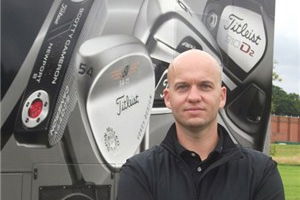NEW DRIVERS: Titleist chief talks 913D2 & D3 model technology
Golfmagic speaks Titleist

While at Stoke Park for the launch of the new Titleist 913D2 and D3 drivers, I caught up with the brand’s US-based general manager of golf clubs, Steve Pelisek.
“Did I mention that Rory won using our new driver?” he jokes as he recalls how McIlroy first got his hands on the 913 D3 model a few weeks before his PGA Championship triumph at Kiawah Island and was so impressed he immediately put it in his bag.
Pelisek told me about the main benefits of the new drivers, as well as explaining some of the key advantages.
How do the 913D2 and 913D3 compare to the earlier 910 drivers?
The launch angles are similar, we didn’t want to play with that. The 913D2 is a lower spinning driver than it was, which we think is good. We also dialled up the sound; we wanted to give a little more ‘crackier’ sound to it.
The D2 is going to be a little more forgiving driver. The D3 isn’t unforgiving but it’s more workable than the D2 - that’s why Rory has the D3 in his bag. He liked the shape of the D2 but with that dynamic closure in the face - and slight draw bias - it didn’t allow him to go after it with his drives. He felt he might turn it over too much.
You say the sound is different. How do you do that?
An amazing amount of science goes into designing sound into a golf club. We like the tone of the new drivers, we like it to be a little louder and last a little longer.
It’s all to do with the thickness of the wall of the clubhead, how it resonates. You can do it retrospectively by putting a little more glue in the head but our designers have integrated the sounds simultaneously.
So what’s the optimum sound for a driver?
We’ve tried to articulate that in the past. It’s difficult but we know what doesn’t sound good. We don’t want it too dull or too loud. The general feedback we get from Tour players and golfers in general is they want a crisp, solid sound that isn’t too loud and that combines with the feel. Our engineers have got it down to frequencies and vibrations.
One of the key differences compared to the 910 drivers is the new face insert.
We have introduced a forged variable thickness insert - still within the USGA COR limits - to make the face faster but over a wider area through tapering. It has been a challenge but we have put a lot of time and energy into that. The 913 drivers now deliver maximum ball speed over a wider area.
The USGA says you are limited by how fast you can make a driver. But within that you’re not limited by how big that area can be by shape, sound or trajectory left to right. So what we’re basically trying to do is make that sweet spot bigger and bigger and use adjustability to allow everyone to dial in exactly what they want.
There has been a lot of discussion about how long a driver shaft should be and what’s the best length. Where does Titleist stand on this?
A longer shaft is generally going to generate more clubhead speed. Put the clubhead on a longer shaft, swing it the same and you’re going to get a little more speed.
But swinging the club same all the time is the challenge. The longer the shafter the tougher it is to swing it the same.
We’ve taken players who play, for example, a 45-inch driver and give them a 46-inch driver and immediately they’re ball speed goes up a little. But come back and test them several weeks later and the ball speed’s back down. They tend to be swinging it slower because they can’t swing that golf club as consistently as a 45-inch driver.
We’ve tried to figure out how long should a driver shaft be and we believe that 45 inches is the best way to go.
The most consistent ball striking guys are those not trying to overpower the golf ball any more. They’re working with their hands and have skill with the short game. They can generally handle a 46-inch driver without too much trouble but the more you get in to guys that are trying to overpower the golf ball its generally not much use in using anything longer than 45 inches.
We point that out all the time that the average length on the US and European Tour is less than 45 inches. And these are the best players in the world. We’ll make it longer but if you ask us to make a driver and put it on a shelf we’re going to make it 45 inches.
Finally can you tell us what influence, if any, Rory McIlroy has had in the development of the D2 and D3 drivers?
We don’t specifically design a golf club for any one player but one of the things we were hearing was that players weren’t putting the 910 driver in their bag because the face closure issue was too great.
That collective feed back played a factor in the design of the next generation 913. It’s not a one-on-one thing. But if there’s a reall issue you hear it from groups of players. Tour feedback is a definite part of the design process.
Rory was one of the 25 guys who gave us feedback.
At such high impact speeds for Tour players, the face closed thing is an issue especially at Kiawah where the fairways were narrow, and the par-4s 500 yards.
Click here for more information on the new Titleist drivers. Share your thoughts in the forum, via @Golfmagic or on our Facebook page.
��

